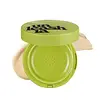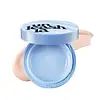What's inside
What's inside
 Key Ingredients
Key Ingredients

 Benefits
Benefits

 Concerns
Concerns

 Ingredients Side-by-side
Ingredients Side-by-side

Water
Skin ConditioningTitanium Dioxide
Cosmetic ColorantDiphenylsiloxy Phenyl Trimethicone
Skin ConditioningButylene Glycol
HumectantButyloctyl Salicylate
Skin ConditioningEthylhexyl Stearate
EmollientC12-15 Alkyl Benzoate
AntimicrobialCyclopentasiloxane
EmollientGlycerin
HumectantCetyl PEG/PPG-10/1 Dimethicone
EmulsifyingPolyglyceryl-4 Isostearate
EmulsifyingPentaerythrityl Tetraisostearate
EmollientNiacinamide
SmoothingSqualane
EmollientPvp
Emulsion StabilisingCyclohexasiloxane
EmollientDimer Dilinoleyl Dimer Dilinoleate
EmollientDisteardimonium Hectorite
StabilisingMagnesium Sulfate
Trimethylsiloxysilicate
EmollientPolyphenylsilsesquioxane
CI 77492
Cosmetic ColorantTribehenin
EmollientAcrylates/Stearyl Acrylate/Dimethicone Methacrylate Copolymer
Aluminum Hydroxide
EmollientCaprylyl Glycol
EmollientTriethoxycaprylylsilane
Bakuchiol
AntimicrobialCI 77491
Cosmetic ColorantEthylhexylglycerin
Skin ConditioningCI 77499
Cosmetic ColorantAdenosine
Skin Conditioning1,2-Hexanediol
Skin ConditioningCarica Papaya Fruit Water
Skin ConditioningChamomilla Recutita Flower Extract
MaskingPolyglutamic Acid
Skin ConditioningPolymethylsilsesquioxane
Carum Petroselinum Extract
Skin ConditioningWater, Titanium Dioxide, Diphenylsiloxy Phenyl Trimethicone, Butylene Glycol, Butyloctyl Salicylate, Ethylhexyl Stearate, C12-15 Alkyl Benzoate, Cyclopentasiloxane, Glycerin, Cetyl PEG/PPG-10/1 Dimethicone, Polyglyceryl-4 Isostearate, Pentaerythrityl Tetraisostearate, Niacinamide, Squalane, Pvp, Cyclohexasiloxane, Dimer Dilinoleyl Dimer Dilinoleate, Disteardimonium Hectorite, Magnesium Sulfate, Trimethylsiloxysilicate, Polyphenylsilsesquioxane, CI 77492, Tribehenin, Acrylates/Stearyl Acrylate/Dimethicone Methacrylate Copolymer, Aluminum Hydroxide, Caprylyl Glycol, Triethoxycaprylylsilane, Bakuchiol, CI 77491, Ethylhexylglycerin, CI 77499, Adenosine, 1,2-Hexanediol, Carica Papaya Fruit Water, Chamomilla Recutita Flower Extract, Polyglutamic Acid, Polymethylsilsesquioxane, Carum Petroselinum Extract
Water
Skin ConditioningCI 77891
Cosmetic ColorantDimethicone
EmollientCaprylyl Methicone
Skin ConditioningIsododecane
EmollientButylene Glycol
HumectantSilica
AbrasiveHydrogenated Polyisobutene
EmollientLauryl PEG-9 Polydimethylsiloxyethyl Dimethicone
Skin ConditioningTrimethylsiloxysilicate
EmollientNiacinamide
SmoothingPentaerythrityl Tetraethylhexanoate
EmollientPhenyl Trimethicone
Skin Conditioning1,2-Hexanediol
Skin ConditioningDisteardimonium Hectorite
StabilisingCetyl PEG/PPG-10/1 Dimethicone
EmulsifyingMagnesium Sulfate
Polyglyceryl-3 Polydimethylsiloxyethyl Dimethicone
Skin ConditioningSynthetic Fluorphlogopite
Octyldodecanol
EmollientPolyhydroxystearic Acid
EmulsifyingAluminum Hydroxide
EmollientDimethicone/Vinyl Dimethicone Crosspolymer
Skin ConditioningVinyl Dimethicone/Methicone Silsesquioxane Crosspolymer
Stearic Acid
CleansingAlumina
AbrasiveTriethoxycaprylylsilane
Glyceryl Behenate/Eicosadioate
EmollientTribehenin
EmollientLecithin
EmollientPolyglyceryl-4 Isostearate
EmulsifyingEthylhexyl Palmitate
EmollientIsopropyl Myristate
EmollientIsostearic Acid
CleansingAdenosine
Skin ConditioningTrisodium Ethylenediamine Disuccinate
Polyglyceryl-3 Polyricinoleate
EmulsifyingIsopropyl Titanium Triisostearate
EmollientNeopentyl Glycol Diethylhexanoate
EmollientTocopherol
AntioxidantPentaerythrityl Tetra-Di-T-Butyl Hydroxyhydrocinnamate
AntioxidantCetearyl Alcohol
EmollientCI 77492
Cosmetic ColorantCI 77491
Cosmetic ColorantCI 77499
Cosmetic ColorantWater, CI 77891, Dimethicone, Caprylyl Methicone, Isododecane, Butylene Glycol, Silica, Hydrogenated Polyisobutene, Lauryl PEG-9 Polydimethylsiloxyethyl Dimethicone, Trimethylsiloxysilicate, Niacinamide, Pentaerythrityl Tetraethylhexanoate, Phenyl Trimethicone, 1,2-Hexanediol, Disteardimonium Hectorite, Cetyl PEG/PPG-10/1 Dimethicone, Magnesium Sulfate, Polyglyceryl-3 Polydimethylsiloxyethyl Dimethicone, Synthetic Fluorphlogopite, Octyldodecanol, Polyhydroxystearic Acid, Aluminum Hydroxide, Dimethicone/Vinyl Dimethicone Crosspolymer, Vinyl Dimethicone/Methicone Silsesquioxane Crosspolymer, Stearic Acid, Alumina, Triethoxycaprylylsilane, Glyceryl Behenate/Eicosadioate, Tribehenin, Lecithin, Polyglyceryl-4 Isostearate, Ethylhexyl Palmitate, Isopropyl Myristate, Isostearic Acid, Adenosine, Trisodium Ethylenediamine Disuccinate, Polyglyceryl-3 Polyricinoleate, Isopropyl Titanium Triisostearate, Neopentyl Glycol Diethylhexanoate, Tocopherol, Pentaerythrityl Tetra-Di-T-Butyl Hydroxyhydrocinnamate, Cetearyl Alcohol, CI 77492, CI 77491, CI 77499
 Reviews
Reviews

Ingredients Explained
These ingredients are found in both products.
Ingredients higher up in an ingredient list are typically present in a larger amount.
1,2-Hexanediol is a synthetic liquid and another multi-functional powerhouse.
It is a:
- Humectant, drawing moisture into the skin
- Emollient, helping to soften skin
- Solvent, dispersing and stabilizing formulas
- Preservative booster, enhancing the antimicrobial activity of other preservatives
Adenosine is in every living organism. It is one of four components in nucleic acids that helps store our DNA.
Adenosine has many benefits when used. These benefits include hydrating the skin, smoothing skin, and reducing wrinkles. Once applied, adenosine increases collagen production. It also helps with improving firmness and tissue repair.
Studies have found adenosine may also help with wound healing.
In skincare products, Adenosine is usually derived from yeast.
Learn more about AdenosineAluminum Hydroxide is a form of aluminum. It can be naturally found in nature as the mineral gibbsite. In cosmetics, Aluminum Hydroxide is used as a colorant, pH adjuster, and absorbent.
As a colorant, Aluminum Hydroxide may add opacity, or reduce the transparency. Aluminum hydroxide is contains both basic and acidic properties.
According to manufacturers, this ingredient is an emollient and humectant. This means it helps hydrate the skin.
In medicine, this ingredient is used to help relieve heartburn and help heal ulcers.
There is currently no credible scientific evidence linking aluminum hydroxide in cosmetics to increased cancer risk.
Major health organizations allow the use of aluminum hydroxide in personal care products and have not flagged it as a carcinogenic risk at typical usage levels.
Learn more about Aluminum HydroxideButylene Glycol (or BG) is used within cosmetic products for a few different reasons:
Overall, Butylene Glycol is a safe and well-rounded ingredient that works well with other ingredients.
Though this ingredient works well with most skin types, some people with sensitive skin may experience a reaction such as allergic rashes, closed comedones, or itchiness.
Learn more about Butylene GlycolThis ingredient is a high molecular weight silicone. It has emulsifying and skin conditioning properties.
Ci 77491 is also hydrated iron III oxide. It's sole purpose is to give a red/pink hue to products.
Iron III oxides are classified as inorganic chemicals for coloring.
Synthetically created Ci 77491 is considered safer than those naturally found. This is because the synthetically created version may contain less impurities. Iron oxides are generally non-toxic and non-allergenic.
Learn more about CI 77491Ci 77492 is also hydrated iron III oxide. It's sole purpose is to give a yellow hue to products.
Iron III oxides are classified as inorganic chemicals for coloring.
Synthetically created Ci 77492 is considered safer than those naturally found. This is because the synthetically created version may contain less impurities. Iron oxides are generally non-toxic and non-allergenic.
Learn more about CI 77492Ci 77499 is also hydrated iron III oxide. It is created from mixing red and black iron oxides. This helps give shades of darkness to a product.
Iron III oxides are classified as inorganic chemicals for coloring.
Disteardimonium Hectorite comes from the clay mineral named hectorite. It is used to add thickness to a product.
It can also help stabilize a product by helping to disperse other ingredients.
Hectorite is a rare, white clay mineral.
Learn more about Disteardimonium HectoriteMagnesium Sulfate is a salt. More specifically, it is an epsom salt, or the bath salt used to help relieve muscle aches.
Despite having ‘sulfate’ in the name, it isn’t a surfactant or cleansing agent like sodium lauryl sulfate. Unlike those sulfates, magnesium sulfate doesn’t have the same cleansing or foaming properties (it's simply a type of salt).
In cosmetics, Magnesium Sulfate is used to thicken a product or help dilute other solids. It is a non-reactive and non-irritating ingredient.
One study shows magnesium deficiency may lead to inflammation of the skin. Applying magnesium topically may help reduce inflammation.
You can find this ingredient in sea water or mineral deposits.
Learn more about Magnesium SulfateNiacinamide is a multitasking form of vitamin B3 that strengthens the skin barrier, reduces pores and dark spots, regulates oil, and improves signs of aging.
And the best part? It's gentle and well-tolerated by most skin types, including sensitive and reactive skin.
You might have heard of "niacin flush", or the reddening of skin that causes itchiness. Niacinamide has not been found to cause this.
In very rare cases, some individuals may not be able to tolerate niacinamide at all or experience an allergic reaction to it.
If you are experiencing flaking, irritation, and dryness with this ingredient, be sure to double check all your products as this ingredient can be found in all categories of skincare.
When incorporating niacinamide into your routine, look out for concentration amounts. Typically, 5% niacinamide provides benefits such as fading dark spots. However, if you have sensitive skin, it is better to begin with a smaller concentration.
When you apply niacinamide to your skin, your body converts it into nicotinamide adenine dinucleotide (NAD). NAD is an essential coenzyme that is already found in your cells as "fuel" and powers countless biological processes.
In your skin, NAD helps repair cell damage, produce new healthy cells, support collagen production, strengthen the skin barrier, and fight environmental stressors (like UV and pollution).
Our natural NAD levels start to decline with age, leading to slower skin repair, visible aging, and a weaker skin barrier. By providing your skin niacinamide, you're recharging your skin's NAD levels. This leads to stronger, healthier, and younger looking skin.
Another name for vitamin B3 is nicotinamide. This vitamin is water-soluble and our bodies don't store it. We obtain Vitamin B3 from either food or skincare. Meat, fish, wheat, yeast, and leafy greens contain vitamin B3.
The type of niacinamide used in skincare is synthetically created.
Learn more about NiacinamideThis ingredient is an emulsifer and stabilizer. It comes from isostearic acid and polyglycerin.
As an emulsifier, it helps blend oil and water to improve texture, spreadbility, and application.
Due to it being derived from isostearic acid, this ingredient may not be fungal acne safe.
Learn more about Polyglyceryl-4 IsostearateTribehenin comes from glycerin and behenic acid.
It is used as an emollient, or moisturizer. Emollients form a thin barrier on skin to prevent moisture from escaping.
This ingredient may not be Malassezia folliculitis, or fungal-acne safe.
Learn more about TribeheninTriethoxycaprylylsilane is a silicone used to bind and stabilize ingredients.
As an emulsifier, it helps prevent ingredients from separating. This can help elongate the shelf life of products.
Triethoxycaprylylsilane is often used to coat mineral sunscreens ingredients to help give a better feel. It also helps reduce oxidative stress in sunscreens.
Learn more about TriethoxycaprylylsilaneThis silicone is an emollient. Emollients create a thin film on the skin to prevent moisture from escaping.
It is not soluble in water and helps increase water-resistance in products.
According to a manufacturer, it can blend seamlessly with silicone oils, such as Cyclopentasiloxane.
Learn more about TrimethylsiloxysilicateWater. It's the most common cosmetic ingredient of all. You'll usually see it at the top of ingredient lists, meaning that it makes up the largest part of the product.
So why is it so popular? Water most often acts as a solvent - this means that it helps dissolve other ingredients into the formulation.
You'll also recognize water as that liquid we all need to stay alive. If you see this, drink a glass of water. Stay hydrated!
Learn more about Water